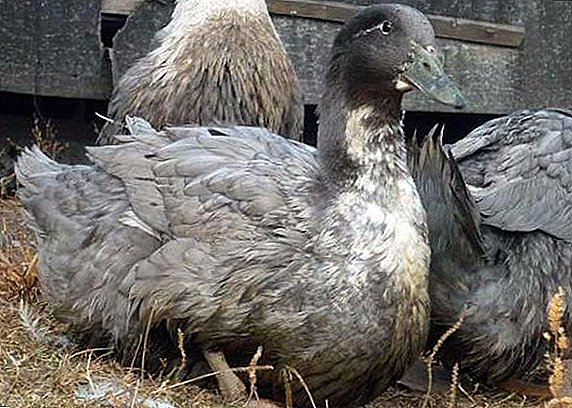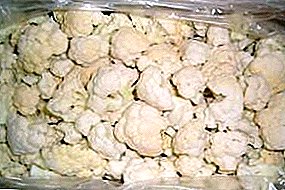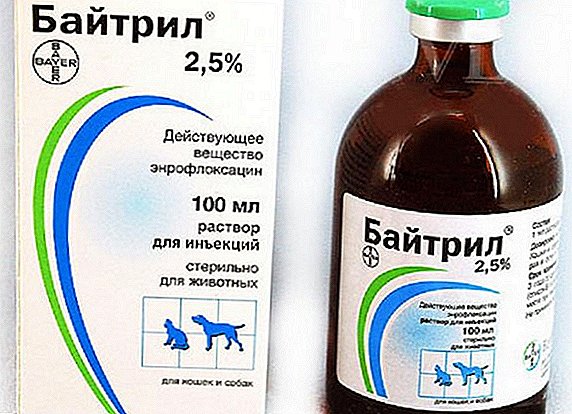 Unforeseen infections harm every household. But the most vulnerable to viruses are chickens and young. It was for the protection of the young bird organism that the Baytril was created.
Unforeseen infections harm every household. But the most vulnerable to viruses are chickens and young. It was for the protection of the young bird organism that the Baytril was created.
This mass drug helps to get rid of infections of the digestive, respiratory and other systems.
How does he act, and how to give it to chickens - about this and tell you next.
What diseases are prescribed
The list of dangerous for chickens and young diseases, there are several dozens of bacterial and parasitic diseases. It is often difficult to determine them, so the birds die in a matter of hours or days. Therefore, right from the outset, it is important to think about the immune system of feathered wards. 
Colibacteriosis
The most serious infection affecting youngsters and causing immeasurable damage to agriculture.
Learn more about the symptoms and treatment of colibacillosis.
With the outbreak of this disease can fall to 30% of the population. The pathogen spreads through water, droppings, food, sewage, and even through egg shells.
Important! Chickens suffer from colibacillosis more often than other types of poultry.
The main signs of the disease:
- thirst while refusing food;
- the blueness of the beak;
- liquid droppings and constantly dirty cesspool.

Salmonellosis
This disease is terrible because a sick bird can infect (for example, through eggs) a person.
Patients with chickens have frothy discharge and symptoms of gastroenteritis:
- loss of appetite;
- bloating;
- dirty anus;
- frequent bowel movements with mucus, blood, and remnants of undigested food pieces.
In addition, signs of the disease can be:
- development inhibition;
- weakness;
- loss of feathers.

When a disease occurs, most of the young are killed. Those who are lucky enough to survive remain weak, underdeveloped and painful.
Pasteurellosis
The most dangerous disease for young age 75-120 days. The pathogen is spread by contact with wild representatives or infected individuals, as well as through inventory and stale bedding. Therefore, the main prevention of pasteurellosis is the observance of sanitary standards.
Learn how to treat pasteurellosis in chickens. Pasteurellosis is also found in cattle, pigs, rabbits.
This disease is characterized by the following symptoms:
- temperature rise up to +43 ° C;
- faintness and ruffled plumage;
- wheezing, heavy breathing;
- frothy discharge from mouth and nose;
- lame walk.

Important! Since pasteurellosis can take place in a disguised form, this leads to the death of the livestock in a month.
Necrotic (ulcerative) enteritis
For whatever reason, birds suffer from ulcerative enteritis, is not fully known. There is a hypothesis that this is a complex disease, in the progression of which reoviruses and a secondary infection are guilty. Chickens suffer from the disease most of all 14-50 days old.
For necrotic enteritis are peculiar to:
- drooping of the head, wings;
- immobility;
- dark-colored dry droppings, sometimes with bloody patches.
When the disease becomes chronic, the young die from impotence. At the same time he eats well, but loses weight and does not develop. 
Streptococcosis
It can occur in two variants: acute (figuratively also called sepsis) and chronic (the bird itself becomes a carrier).
The causative agent of the disease is streptococcus bacteria. Not only young animals are infected, but also embryos. The source of infection is furniture, contaminated feed, inventory. The risk of infection increases with a lack of nutrition or vitamins, as well as injury to the skin.
Did you know? Some breeds of chickens due to a narrow pelvis or other anomalies never lay eggs.
In the acute form of streptococcosis, the function of blood formation worsens. And the death of a bird can come in a day without any signs. However, the main symptoms that can mean infection are blockage of chickens, stiffness of movement. Most birds die in a few days. 
Staphylococcosis
Similar in symptoms with cholera. The causative agent is the bacillus of a variety of staphylococcus. Infection occurs through injured skin, mucous membranes, and digestive tract.
Once in the body, bacteria produce inflammatory reactions. The incubation period lasts from several hours to 5-6 days. The development process can be rapid, acute and chronic. With lightning development, clinical signs are mostly not manifested and the chicken dies in 12-24 hours.
In the phase of acute development (lasts 5-7 days) the following symptoms are observed:
- obvious depression;
- loss of appetite;
- cyanosis of the scalp;
- hyperemia of the pharyngeal mucosa;
- diarrhea;
- ruffled plumage;
- conjunctivitis;
- exhaustion.

In chronic course, local limb lesions, inflammation of the joints, paresis, loss of appetite, exhaustion are noted.
Mycoplasmosis
The most dangerous disease that can occur due to non-compliance with the rules of content. The incubation period lasts 17-20 days. The source of infection can be soil, grass, feces, various plants. When infected, respiratory organs and air sacs are affected.
When mycoplasmosis can also apply "Brovafom new", "Enroksil", "ASD fraction 2".
Symptoms appear only with the development of the disease (stage 2-3).
These include:
- nasal mucus;
- sneeze;
- heavy, wheezing, breathing;
- cough;
- eye redness;
- puffiness of the eyelids;
- loss of appetite;
- lethargy;
- excreta liquid, greenish or yellowish.

Chickens are infected from the hen during embryonic development. Often mycoplasmosis occurs with echinococcosis and is dangerous for a high percentage of mortality.
Did you know? Chickens lay eggs in the light. Even if it is time to lay, the hen will wait for the morning to come.
Dosage
"Baytril" is an oral antibacterial drug for the treatment of infectious diseases in birds. 1 ml of the drug contains 100 mg of enrofloxacin. It is a clear solution with a yellowish tinge.
It will also be useful for you to learn how to use "Baytril 10%".
For the treatment of diseases caused by mycoplasmas, gram-positive and gram-negative bacteria, apply the dosage according to the table.
| Destination birds | Age, weeks | "Baytril", ml per 100 l of water |
| Broilers | 1-3 | 50 |
| Broilers for breeding | 3 | 50 |
| Egg Broilers | 1-5 | 50 |

With salmonellosis, chronic diseases, mixed infections (from 4 and 6 weeks, respectively), the dose of the drug is increased to 100 ml per 100 liters of water.
For older individuals (broilers at the end of fattening or laying hens), the rate is calculated on the basis of the minimum recommended amount: 10 mg of active ingredient per 1 kg of bird weight.
The therapy period is 3-5 days. For salmonellosis and complex infections, the course is 5 days or more.
Mode of application
Begin to give "Baytril" chickens can be after reaching the age of 2 weeks. In poultry farming, the preparation is diluted with water and given instead of drinking to feathered animals.
Important! Be sure to calculate the daily rate of fluid for birds, to prevent an oversupply of the drug or a shortage of drinking.
To avoid complications, the manufacturer advises to change the treatment solution daily. When treating chickens, it is necessary to take into account that enrofloxacin is eliminated from the body after 11 days. Therefore, it is impossible to consume the meat of such a bird earlier than this period. 
Contraindications
Unfortunately, in some cases it is not recommended to give "Baytril" birds.
The list of such options include:
- Laying period. Enrofloxacin, which is part of the preparation, is accumulated in eggs as a result of the intake.
- If birds are taking certain drugs (chloramphenicol, theophylline, tetracycline or macrolide, nonsteroidal anti-inflammatory drugs, Marek's vaccine).
- Before slaughter. You must stop giving the drug for 10-12 days before slaughter.
In addition, it is worth mentioning that "Baytril" is a fairly strong antibiotic, so when it is used, such negative reactions often occur:
- loose stools;
- allergy;
- violation of the microbiocenosis of the gastrointestinal tract (used for the treatment of probiotics);
- lethargy;
- immunity to external stimuli.

Did you know? The intensity of the color of the eggshell may be affected by the age of the hen, the type of food, the lighting mode and the temperature.
In addition, it is necessary to thoroughly study the instructions for use and to comply with certain safety measures and hygiene rules that are required when working with medical preparations for animals:
- during work with the drug can not drink or smoke;
- after handling, wash your hands thoroughly with soap and water;
- in case of contact with the skin or mucous membranes, immediately rinse this place under strong water pressure;
- the container in which the Baytril was located is disposed of according to the principle of household waste. The use of these containers for other purposes is prohibited.
As we see, the statement that it is difficult for a farmer to do without medicines when breeding a bird is true. Now you know about the main symptoms of dangerous diseases of chickens and about an effective means of treating them.












